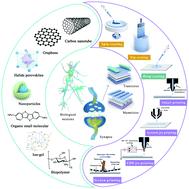当前位置:
X-MOL 学术
›
Mater. Horiz.
›
论文详情
Our official English website, www.x-mol.net, welcomes your
feedback! (Note: you will need to create a separate account there.)
Solution-processed electronics for artificial synapses
Materials Horizons ( IF 12.2 ) Pub Date : 2020-10-23 , DOI: 10.1039/d0mh01520b Kuakua Lu 1 , Xiaomeng Li , Qingqing Sun , Xinchang Pang , Jinzhou Chen , Takeo Minari , Xuying Liu , Yanlin Song
Materials Horizons ( IF 12.2 ) Pub Date : 2020-10-23 , DOI: 10.1039/d0mh01520b Kuakua Lu 1 , Xiaomeng Li , Qingqing Sun , Xinchang Pang , Jinzhou Chen , Takeo Minari , Xuying Liu , Yanlin Song
Affiliation

|
Artificial synaptic devices and systems have become hot topics due to parallel computing, high plasticity, integration of storage, and processing to meet the challenges of the traditional Von Neumann computers. Currently, two-terminal memristors and three-terminal transistors have been mainly developed for high-density storage with high switching speed and high reliability because of the adjustable resistivity, controllable ion migration, and abundant choices of functional materials and fabrication processes. To achieve the low-cost, large-scale, and easy-process fabrication, solution-processed techniques have been extensively employed to develop synaptic electronics towards flexible and highly integrated three-dimensional (3D) neural networks. Herein, we have summarized and discussed solution-processed techniques in the fabrication of two-terminal memristors and three-terminal transistors for the application of artificial synaptic electronics mainly reported in the recent five years from the view of fabrication processes, functional materials, electronic operating mechanisms, and system applications. Furthermore, the challenges and prospects were discussed in depth to promote solution-processed techniques in the future development of artificial synapse with high performance and high integration.
中文翻译:

用于人工突触的溶液处理电子器件
人工突触设备和系统由于并行计算、高可塑性、集成存储和处理以应对传统冯诺依曼计算机的挑战而成为热门话题。目前,二端忆阻器和三端晶体管由于其电阻率可调、离子迁移可控、功能材料和制造工艺选择丰富等特点,主要用于高密度存储,具有高开关速度和高可靠性。为了实现低成本、大规模和易于加工的制造,溶液处理技术已被广泛用于向灵活且高度集成的三维 (3D) 神经网络开发突触电子学。在此处,我们从制造工艺、功能材料、电子操作机制、和系统应用。此外,还深入讨论了解决方案处理技术在未来高性能和高集成度人工突触发展中面临的挑战和前景。
更新日期:2020-11-27
中文翻译:

用于人工突触的溶液处理电子器件
人工突触设备和系统由于并行计算、高可塑性、集成存储和处理以应对传统冯诺依曼计算机的挑战而成为热门话题。目前,二端忆阻器和三端晶体管由于其电阻率可调、离子迁移可控、功能材料和制造工艺选择丰富等特点,主要用于高密度存储,具有高开关速度和高可靠性。为了实现低成本、大规模和易于加工的制造,溶液处理技术已被广泛用于向灵活且高度集成的三维 (3D) 神经网络开发突触电子学。在此处,我们从制造工艺、功能材料、电子操作机制、和系统应用。此外,还深入讨论了解决方案处理技术在未来高性能和高集成度人工突触发展中面临的挑战和前景。









































 京公网安备 11010802027423号
京公网安备 11010802027423号